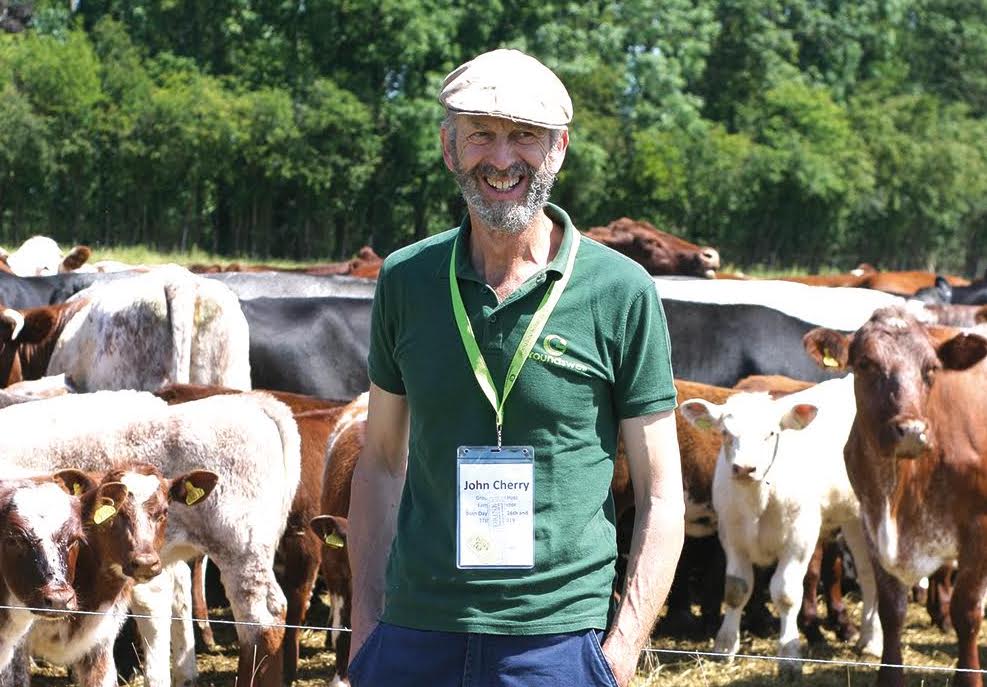

John Cherry, a fourth generation farmer, is one of the founders of Groundswell - the no till and regenerative agriculture show, which advocates no tillage. This policy also governs how the Cherrys run their predominantly arable farm.
‘We’ve been 100% no till since 2010,’ says John. ‘That’s nearly ten years of continuous no till and it gets better all the time, with lovely, friable soil underneath.’
Five hundred acres of the Cherry’s farm is down to permanent pasture, and the rest is arable - wheat, barley, oats, rye, beans, with 150 acres of herbal ley currently in the rotation, sown over the last few years. John was inspired to use herbal leys after reading older agricultural books by Newman Turner, and Robert Elliot’s ‘Clifton Park Farming System’ and discovering more recently what arable farmers were doing in the USA. ‘They were using herbal leys in arable rotations and the effects on the soil were amazing.’
The herbal ley is mob-grazed with a herd of about 400 Shorthorn cattle, which are moved once or twice a day and given about 0.5 ha at any one time. ‘They love the mix of species and do very well on it and the ley responds well to mob-grazing. ‘When the animals move onto a small patch they don’t cherry pick but have to eat everything in front of them before their neighbours steal it.
You get better grazing, since they eat all the seed heads and still leave some stuff standing so the plants can still photosynthesize and promote strong regrowth, the rest of the ground is covered with trodden plant material, which breaks down, helping further improve soil fertility.’
John says that including livestock in an arable rotation is ‘relatively easy.’ He says the electric fencing took time, but was relatively cheap and the water was a bit complicated but overall worth the effort.
John talks with great enthusiasm about the variety of different plants and different root architecture in the mix - there are 19 species in the Cotswold Herbal Ley and as many reasons to use herbal leys. ‘We used the herbal ley to help get rid of blackgrass as well as adding fertility by turning forage into dung. The deep roots break through the soil and bring minerals up from lower down. Different species grow at different times of year, improving the growing season and they cope well with drier weather conditions.’
John’s farm is not certified organic but crops are treated as low input with no spraying or use of fertiliser. ‘We don’t need to because the herbal ley is full of fertility building legume plants.’
John says the herbal ley farming system is a natural fit with the principles of no till. ‘We love no till because it leaves the soil undisturbed and keeps living roots in the ground which is good for soil life. Meantime, the deep rooting herbal ley improves soil structure further down and hugely improves soil fertility thanks to the high legume content. All contributing to a healthy soil to support his no till system’.
Groundswell, now in its fourth year, offers farmer to farmer, peer to peer learning from all over the world, lots of chatting and sharing ideas. So what advice does John have for other farmers thinking of experimenting with no till.
‘Take 10% of your land and give it a go. We played around with little patches and it made so much sense. Why spend all day sitting on a power harrow when you don’t need to? It saves so much money - less machinery, less diesel. It’s good for farmers and for the planet, locking in carbon, stopping floods and erosion. Not disturbing the soil, and keeping it well covered, is universally good practice.’
Date Posted: 7th April 2020



